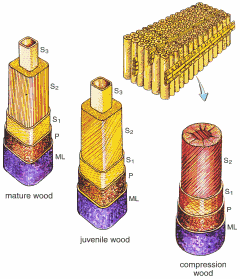Summary

Investigating the biosynthesis and structure of wood macromolecules and their effects on wood properties and products
Summary
The major components of plant cell walls are cellulose, hemicelluloses and lignin. The structure and orientation of these macro molecules determines the strength of solid wood and fibres. Forest Research led this European collaboration to learn more about the formation and targeted alteration of fibres. The project used laboratory and field-based techniques to study biosynthesis and characterise the micro-structures and properties of wood, especially the “reaction wood” deposited around areas of strained growth.
Key findings and outputs
- Major advances: new insights and understanding of the cellulose biosynthetic mechanism, the chemistry of lignification and the distribution of lignin in the fibre cell wall
- Short-Term Scientific Missions: early-stage researchers visited experts and laboratories to learn new techniques for analysing cell wall structure
- Discoveries: researchers found new forms of tension wood and observed a much wider variation in types of reaction wood than previously documented
- Workshops: joint meetings with COST Action E41 (‘Analytical tools with applications for wood and pulping chemistry’) and the International Lignin Institute to forge new research links between EC and non-EC laboratories
Our involvement
Forest Research coordinated the project, leading a consortium of partners from 11 countries.
Publications
Funders and partners
![]()
The project received funding through the EU COST programme (Action E50).
Forest Research worked with partners from 28 other institutions and research organisations from Austria, Belgium, Finland, France, Germany, Italy, Poland, Slovenia, Sweden, Switzerland, The Netherlands and the UK.
Status
The programme was completed in July 2009.
General Content
What’s of interest
Please note: All presentations and publications regarding this project have now been archived.
